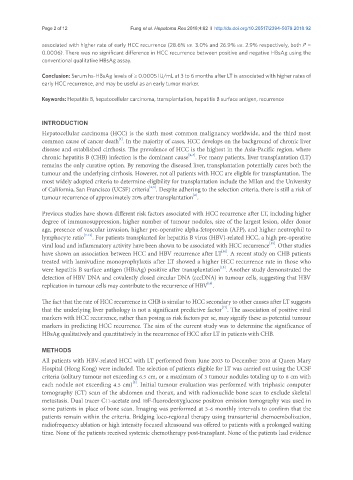Page 689 - Read Online
P. 689
Page 2 of 12 Fung et al. Hepatoma Res 2018;4:62 I http://dx.doi.org/10.20517/2394-5079.2018.92
associated with higher rate of early HCC recurrence (28.6% vs. 3.0% and 26.9% vs. 2.9% respectively, both P =
0.0006). There was no significant difference in HCC recurrence between positive and negative HBsAg using the
conventional qualitative HBsAg assay.
Conclusion: Serum hs-HBsAg levels of ≥ 0.0005 IU/mL at 3 to 6 months after LT is associated with higher rates of
early HCC recurrence, and may be useful as an early tumor marker.
Keywords: Hepatitis B, hepatocellular carcinoma, transplantation, hepatitis B surface antigen, recurrence
INTRODUCTION
Hepatocellular carcinoma (HCC) is the sixth most common malignancy worldwide, and the third most
[1]
common cause of cancer death . In the majority of cases, HCC develops on the background of chronic liver
disease and established cirrhosis. The prevalence of HCC is the highest in the Asia-Pacific region, where
[2,3]
chronic hepatitis B (CHB) infection is the dominant cause . For many patients, liver transplantation (LT)
remains the only curative option. By removing the diseased liver, transplantation potentially cures both the
tumour and the underlying cirrhosis. However, not all patients with HCC are eligible for transplantation. The
most widely adopted criteria to determine eligibility for transplantation include the Milan and the University
[4,5]
of California, San Francisco (UCSF) criteria . Despite adhering to the selection criteria, there is still a risk of
[6]
tumour recurrence of approximately 20% after transplantation .
Previous studies have shown different risk factors associated with HCC recurrence after LT, including higher
degree of immunosuppression, higher number of tumour nodules, size of the largest lesion, older donor
age, presence of vascular invasion, higher pre-operative alpha-fetoprotein (AFP), and higher neutrophil to
lymphocyte ratio [7-12] . For patients transplanted for hepatitis B virus (HBV)-related HCC, a high pre-operative
[13]
viral load and inflammatory activity have been shown to be associated with HCC recurrence . Other studies
[14]
have shown an association between HCC and HBV recurrence after LT . A recent study on CHB patients
treated with lamivudine monoprophylaxis after LT showed a higher HCC recurrence rate in those who
[15]
were hepatitis B surface antigen (HBsAg) positive after transplantation . Another study demonstrated the
detection of HBV DNA and covalently closed circular DNA (cccDNA) in tumour cells, suggesting that HBV
[16]
replication in tumour cells may contribute to the recurrence of HBV .
The fact that the rate of HCC recurrence in CHB is similar to HCC secondary to other causes after LT suggests
[17]
that the underlying liver pathology is not a significant predictive factor . The association of positive viral
markers with HCC recurrence, rather than posing as risk factors per se, may signify these as potential tumour
markers in predicting HCC recurrence. The aim of the current study was to determine the significance of
HBsAg qualitatively and quantitatively in the recurrence of HCC after LT in patients with CHB.
METHODS
All patients with HBV-related HCC with LT performed from June 2003 to December 2010 at Queen Mary
Hospital (Hong Kong) were included. The selection of patients eligible for LT was carried out using the UCSF
criteria (solitary tumour not exceeding 6.5 cm, or a maximum of 3 tumour nodules totaling up to 8 cm with
[5]
each nodule not exceeding 4.5 cm) . Initial tumour evaluation was performed with triphasic computer
tomography (CT) scan of the abdomen and thorax, and with radionuclide bone scan to exclude skeletal
metastasis. Dual tracer C11-acetate and 18F-fluorodeoxyglucose positron emission tomography was used in
some patients in place of bone scan. Imaging was performed at 3-6 monthly intervals to confirm that the
patients remain within the criteria. Bridging loco-regional therapy using transarterial chemoembolization,
radiofrequency ablation or high intensity focused ultrasound was offered to patients with a prolonged waiting
time. None of the patients received systemic chemotherapy post-transplant. None of the patients had evidence

